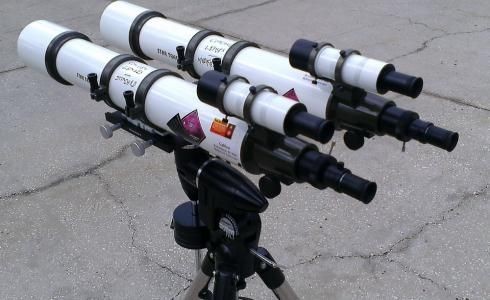Astrophotography looking bright for both pros and amateurs
| Eana Maniebo | | Nov 26, 2015 02:11 PM EST |
One of the latest addition to astrophotography: the Santilli Telescope.
New advancements have been made that will benefit astrophotography in the professional and amateur level. This week, a computerised telescope that can be connected to cameras and television sets started its operation at the New Plymouth Observatory. At the same time, ON Semiconductor has made a new 16.2 megapixel charge-coupled device (CCD) image sensor available to the public.
Like Us on Facebook
These two additions to astrophotography follow the trend of using cameras, not only to behold the beauty of outer space but to use them for discoveries. Most recently, scientists have independently confirmed the first-ever detections of antimatter celestial bodies through the Santilli Telescope.
Created by breakthrough technology leader Thunder Energies Corporation (OTCQB: TNRG), the antimatter telescope features the Canon's camera model EOS 600D with image sensor of type CMOS, and Bayer Filter. As human eyes are not able to see antimatter, the camera was crucial for the detections made. The conversion from analogue to digital allows the storage of raw data or their conversion into visible images in the LCD screen, as well as for storage in said visible format.
Final Frontier Closer
Residents of Taranaki, a region in the west of New Zealand's North Island, will benefit from the installation of a computerised telescope with the capacity of connecting to cameras and television sets. Tagged at about $80,000, the new installation was realized after three years of planning and fundraising.
Nick Gladstone, president of New Plymouth Astronomical Society (NPAS), explained that the project began when the Society had a discussion on an upgrade to a telescope which would enable photography. The existing telescope they had was a little outdated to suit the plan.
"In 1920, it was the best telescope in Taranaki. Now, any astronomer who can afford a small boat can buy a telescope," Gladstone said. He added that the new installation will not only bring a new way to educate people about space, but also present an opportunity to try their hand at astrophotography.
"There's a lot of colour that we don't see with the eye or a camera," NPAS member Leith Robertson said. He has been an astrophotographer for two years and joined the NPAS specifically for the telescope after Gladstone mentioned the project to him one starry night.
A flat screen television that can be connected to the new telescope was also installed in the observatory's lecture room which will allow more people to the observe beauty of the universe at the same time.
"Now we can have 30 to 40 people looking at the same thing rather than one person pressing their eyeball to the telescope," Gladstone said.
In particular, the new telescope was meant to get the youth "interested in the whole space thing" and to give visitors a different experience.
"The plan is to try to create a greater involvement in schools and other organisations," Robertson said.
Expanding Options for Astrophotography
ON Semiconductor has also joined in the advancements in image capture for demanding astrophotography and scientific imaging applications. Its new KAF-16200 CCD image sensor leverages the advanced design and manufacturing capabilities of the company to enable image capture in high resolution and low noise.
The device's Full Frame CCD architecture is top-of-the-line in class image uniformity and dark current. High sensitivity, high dynamic range, and integrated overexposure protection are achieved through the use of 6.0 micrometer (µm) pixels with a transparent gate electrode. Both of CCD and pixels of KAF-16200 are responsible for the exceptional imagery and detail in an APS-H (34.6 mm diagonal) optical format. ON Semiconductor's Image Sensor Group in the Industrial and Security Division is in charge of the new product.
"This new image sensor targets opportunities directly identified by our camera manufacturing customers. The KAF-16200 provides a 2x increase in resolution compared to our current device addressing this segment, without sacrificing the CCD-level image quality required for these applications. This is another example of ON Semiconductor's ability to leverage a broad technology base to provide the highest quality image sensor devices regardless of the underlying technology," said Herb Erhardt, Vice President and General Manager of the said division.
Tagsastrophotography, photos in outer space, Santilli telescope, Thunder Energies, Antimatter, New Plymouth Astronomical Society, Taranaki, New Plymouth Observatory, ON Semiconductor
©2015 Chinatopix All rights reserved. Do not reproduce without permission
EDITOR'S PICKS
-

Did the Trump administration just announce plans for a trade war with ‘hostile’ China and Russia?
-

US Senate passes Taiwan travel bill slammed by China
-

As Yan Sihong’s family grieves, here are other Chinese students who went missing abroad. Some have never been found
-

Beijing blasts Western critics who ‘smear China’ with the term sharp power
-

China Envoy Seeks to Defuse Tensions With U.S. as a Trade War Brews
-

Singapore's Deputy PM Provides Bitcoin Vote of Confidence Amid China's Blanket Bans
-

China warns investors over risks in overseas virtual currency trading
-

Chinese government most trustworthy: survey
-

Kashima Antlers On Course For Back-To-Back Titles
MOST POPULAR
LATEST NEWS
Zhou Yongkang: China's Former Security Chief Sentenced to Life in Prison

China's former Chief of the Ministry of Public Security, Zhou Yongkang, has been given a life sentence after he was found guilty of abusing his office, bribery and deliberately ... Full Article
TRENDING STORY

China Pork Prices Expected to Stabilize As The Supplies Recover

Elephone P9000 Smartphone is now on Sale on Amazon India

There's a Big Chance Cliffhangers Won't Still Be Resolved When Grey's Anatomy Season 13 Returns

Supreme Court Ruled on Samsung vs Apple Dispute for Patent Infringement

Microsoft Surface Pro 5 Rumors and Release Date: What is the Latest?










